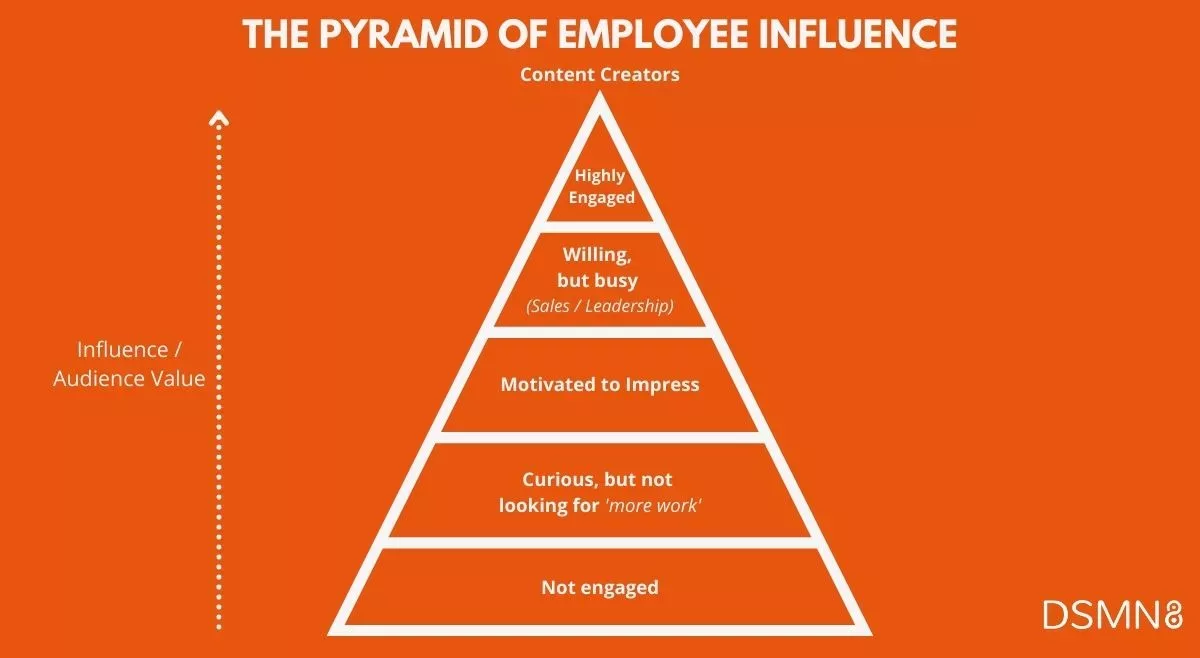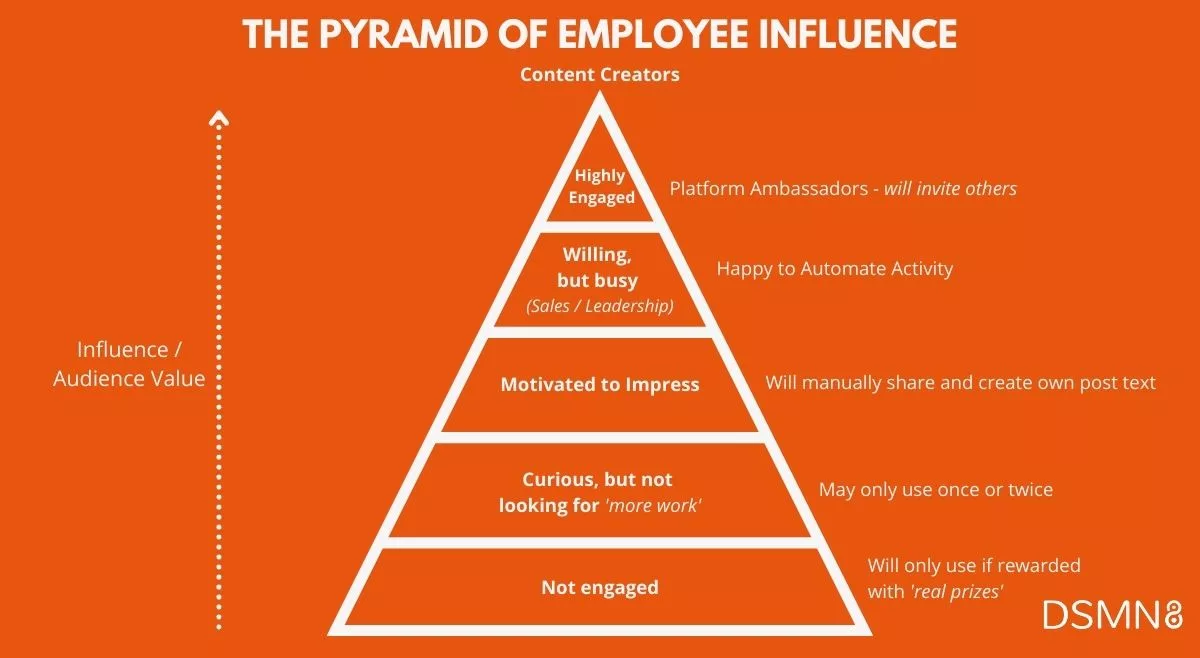
Last updated: 8th April 2024
“How many employees do I need for employee advocacy to be a success?”
It might not be the first thing that comes to mind when you consider an employee influencer or advocacy program.
But it’s something we’re frequently asked about as we partner with clients on the journey to success.
To answer this question, you need to first decide what you want to achieve from your program.
Are you trying to achieve specific marketing goals?
Then maybe you want to grow your reach, boost engagement, and increase website conversions.
On average, just 3% of employees share content about their organization.
Yet, they’re responsible for driving a whopping 30% increase in engagement.
So, why waste your time and money on paid social? 🤷♂️
Maybe you’re starting an employee influence or advocacy program because you want to elevate your employer brand?
No doubt, the metrics I previously mentioned will be important to you, but maybe what you want is to just get employees showcasing your company culture and sharing more on-brand content.
After all, employee referrals make up just 7% of all applicants, but 70% of all hires.
So, what better way to attract top talent?
Looking to amplify your sales team’s social media presence and capitalize on social selling?
I don’t blame you!
78% of social sellers outsell peers who don’t use social media.
So, can you afford to have them not using social media?

The truth is, the question isn’t “how many employees do I need”.
It’s “which employees should I invite? Who has the influence to make a real impact?”.
No matter how many employees you have, some of them will get it, and others couldn’t care less about a new initiative.
And that’s okay… Being active on social media isn’t for everyone 👍
It’s a harsh reality, but you can’t expect that all employees will be highly engaged and looking to take part in something new.
So, we’ve identified five employee groups and created ‘The Pyramid of Employee Influence’.
It’ll help you understand the different types of employees, and which ones will have the most impact on your employee advocacy program.
What is "The Pyramid of Employee Influence"?
Identifying your employee influencers.
It’s up there with “how many people do I need to invite”.
While this pyramid won’t necessarily single out your most influential employees, it should help you identify which employees are the best fit for your program.
It should also make you realize that employee advocacy isn’t a numbers game 🙅♂️
It doesn’t necessarily matter how many employees you invite; it’s about identifying and inviting the right employees.
You’ll see that the higher up the pyramid each group is, the more influence they have.
There will be less of them at the top, but again, it’s about getting the right people involved.
Sometimes, one employee can generate results that 20 employees could only dream of!
The right people aren’t always the most willing (a busy CEO, for example), but they’re not to be ignored.
We’ll get into how you can get the “difficult groups” to participate in your program.
But first, let’s break down each group:
Group 1: Not Engaged
At the base of the pyramid, you have the employees who are not engaged.
Nobody wants to think they have too many of these, but the reality is that they’re there.
This is especially true within larger organizations.
It doesn’t necessarily mean that they’re unhappy (perhaps they’re thinking of changing roles soon).
They’re just disengaged and not looking for more involvement, so they’re not likely to share.
But once again, with the right program/incentives in place, they’re not to be forgotten about.
These wouldn’t be your ideal candidates to invite at first.

Group 2: Curious, but not looking for more work
If you’ve launched a program of your own, you’ll know that nothing about an employee influencer or advocacy program is hard work for employees.
The goal is to make it as straightforward, accessible, and as fun as possible.
Nevertheless, we have to accept that a good chunk of employees are busy, quite content, and not looking to go what they think is “the extra mile”.
For these people, we believe that education of the benefits is key.
Why should they share? What’s in it for them?
Check out our infographic on the importance of personal branding for a quick guide, or our article about the benefits of employee advocacy for employees for a deep-dive.
Like the disengaged, this group won’t be your first choice.
Without proper guidance and education, they might only participate once or twice.
But they’re not to be disregarded completely.

Group 3: Motivated to Impress
We love this next bunch.
The “Motivated to Impress” sit right in the middle of our pyramid.
These people want to be seen and are willing/want to contribute to the program.
Perhaps they see themselves as being at the start of their career ladder, or they’re new to the company. Either way, they get it.
And they’re eager to take part.
If they’re at a point in their career where they want to progress, they’ll understand the benefits of personal branding.
They might not wield the same influence as those higher up, but what they do have is motivation, an understanding, and the strength in numbers to really make a difference to your program!
This is the ideal group for those looking to introduce an employee influence or advocacy program to their organization. They’re also the perfect group for running a pilot program to prove the impact of employees sharing on social media.

Group 4: Willing, but busy
The penultimate group have, in the past, been a tricky bunch.
They are willing to take part, but they are also swamped.
These people see the value and understand why the program is important, but they don’t have the time to contribute in a meaningful way.
It doesn’t immediately affect their goals or have an impact on what’s expected of them, so it’s deprioritized.
Nevertheless, they typically have larger followings on social.
Think about it… people want to be connected to senior leaders in their field. They want to read content, POVs and thought leadership from people in this very group.
As a Marketing Executive, I want to be connected with Marketing Directors, CMOs, Heads of Marketing, Marketing Academics, etc.
The point is, people seek out these connections, and they want to engage with those who can add value to their own social feeds, personal development, education, and professional career.
So, not only do this group of employees have a huge audience, but they generate eye-watering reach and engagement, too!
Needless to say, you shouldn’t be forgetting about them.
Group 5: Content Creators & Platform Ambassadors
Lastly, we have our brand ambassadors, content creators, and full-blown employee influencers.
The “creme de la creme”!
These are your highly engaged employees and the ones who wield the most influence on social media.
You might already know who they are.
Perhaps they get hundreds or thousands of views and engagements on their posts.
Not only do these people see the value of advocacy…
They reap the rewards on social media.
They understand personal branding and the importance of creating content.
Perhaps they’re a combination of a few of your other groups.
For example, they’re senior leaders, motivated, busy, but going the extra mile!
Your content creators and program ambassadors are what separates an advocate from an employee influencer 🙌
How is DSMN8 different from traditional employee advocacy solutions?
Now that we have a rough breakdown, you might be thinking…
“So, just invite the Motivated to Impress bunch?”
Hold your horses ✋
Typically, most employee advocacy platforms cater to just these people.
The advocates.
But we said “to heck with that” a long time ago!
While we know that they’re the easiest to get on board, we want to get everything out of this program to truly guarantee its success and generate real business impact.
Which means us going above and beyond to ensure that everyone can play a part.
We’re not just going to ignore that CTO with 5,000 followers on LinkedIn who is too busy to take part.

How?
Sure, the disengaged might not want to share, the senior leaders haven’t got the time, and the curious folk might not be looking for more work…
What do we say to that? Features to the rescue! 💪
Features that mean everybody can take part in a way that works for them.
We recognized early on that you might lose some of your biggest players due to time constraints.
This is why we launched our automation feature with smart scheduling so that (in theory) those busy bees could only ever have to log in once 🐝
Once they connect their LinkedIn account, they can choose how many times they want to post per day, per week, or even per month.
And voila!
Thanks to proactive admin users who are writing multiple captions for each post, you’ve got your senior leaders sharing quality personalized content to their many, many followers, with zero effort required on their part.

Re-engage the Disengaged
Okay, so what about the lower groups, the less engaged, and the not engaged?
Gamification, leaderboards, and rewards. Heck, throw in automated posting too, for good measure!
They may only use the platform once or twice at first, but what’s to stop you from launching incentives in the form of leaderboards and rewards for top sharers?
Sure, they’re not looking for more work, but the friendly competitive nature of leaderboards (and the possibility of winning a prize) will have people coming back 👏
Communicating the benefits is one thing, but you’ll be looking to communicate the competition, excitement, and chance to win rewards for the disengaged.

Nurture Your Employee Influencers
How do we help the people at the top?
The people at the top of the pyramid are what separates employee influence from employee advocacy.
It’s also why we consider ourselves to be an employee influencer platform and not just another advocacy tool!
Time is precious for everyone, even those who see the value ⏳
Centralizing your content and creating personalized feeds of relevant content for every employee is how you give these people the latest and greatest from your company.
And don’t forget, they’re also inadvertently getting others involved!
If they’re big on social, they almost always hold internal influence too.

Think that’s exciting?
Wait ’til you see what we’ve got in the pipeline 👀
I’m talking employee influence 2.0.
Authentic employee-generated content at scale.
Content creation, curation, and sharing, all in one place.
Next level employee advocacy and analytics like you’ve never seen 🚀
We’re turning employees into content creators and reputable brand advocates no matter which group on the pyramid they fall under.
In the meantime, now that you know how.
Are you ready to get started?
If you want to launch a program of your own, or simply want to learn more about the staggering effects of employee influence, then get in touch! 👇
Podcast Episode on the Pyramid of Employee Influence 🎧
Join DSMN8’s CEO Bradley Keenan, as he discusses the Pyramid of Employee Influence in an episode of our podcast.
Lewis Gray
Senior Marketing Manager and Employee Advocacy Program Manager at DSMN8. Lewis specialises in content strategy, growing brand visibility and generating inbound leads. His background in Sales lends itself well to demand generation in the B2B niche.





